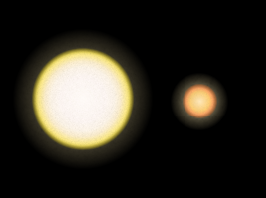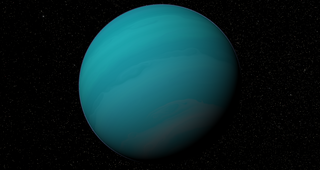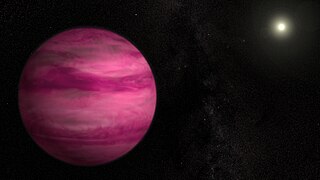
Gliese 876 is a red dwarf approximately 15 light-years away from Earth in the constellation of Aquarius. It is one of the closest known stars to the Sun confirmed to possess a planetary system with more than two planets, after Gliese 1061, YZ Ceti, Tau Ceti, and Luyten's Star; as of 2018, four extrasolar planets have been found to orbit the star. The planetary system is also notable for the orbital properties of its planets. It is the only known system of orbital companions to exhibit a near-triple conjunction in the rare phenomenon of Laplace resonance. It is also the first extrasolar system around a normal star with measured coplanarity. While planets b and c are located in the system's habitable zone, they are giant planets believed to be analogous to Jupiter.
Gliese 436 is a red dwarf approximately 31.8 light-years away in the zodiac constellation of Leo. It has an apparent visual magnitude of 10.67, which is much too faint to be seen with the naked eye. However, it can be viewed with even a modest telescope of 2.4 in (6 cm) aperture. In 2004, the existence of an extrasolar planet, Gliese 436b, was verified as orbiting the star. This planet was later discovered to transit its host star.

Gliese 229 is a binary system composed of red dwarf and brown dwarf about 19 light years away in the constellation Lepus. The primary component has 58% of the mass of the Sun, 69% of the Sun's radius, and a very low projected rotation velocity of 1 km/s at the stellar equator.
Gliese 777, often abbreviated as Gl 777 or GJ 777, is a yellow subgiant approximately 52 light-years away in the constellation of Cygnus. The system is also a binary star system made up of two stars and possibly a third. As of 2005, two extrasolar planets are known to orbit the primary star.

Gliese 581 is a star of spectral type M3V at the center of the Gliese 581 planetary system, about 20 light years away from Earth in the Libra constellation. Its estimated mass is about a third of that of the Sun, and it is the 89th closest known star to the Sun. Gliese 581 is one of the oldest, least active M dwarfs, its low stellar activity bodes better than most for its planets retaining significant atmospheres and from the sterilising impact of stellar flares.

Gliese 581b or Gl 581b is an extrasolar planet orbiting within the Gliese 581 system. It is the first planet of four confirmed in the system so far, and the second in order from the star.

Gliese 876 d is an exoplanet approximately 15 light-years away in the constellation of Aquarius. The planet was the third planet discovered orbiting the red dwarf Gliese 876. It was the lowest-mass extrasolar planet apart from the pulsar planets orbiting PSR B1257+12 at the time of its discovery. Due to this low mass, it can be categorized as a super-Earth.

Gliese 876 c is an exoplanet orbiting the red dwarf Gliese 876, taking about 30 days to complete an orbit. The planet was discovered in April 2001 and is the second planet in order of increasing distance from its star.

Gliese 876 b is an exoplanet orbiting the red dwarf Gliese 876. It completes one orbit in approximately 61 days. Discovered in June 1998, Gliese 876 b was the first planet to be discovered orbiting a red dwarf.

Gliese 436 b is a Neptune-sized exoplanet orbiting the red dwarf Gliese 436. It was the first hot Neptune discovered with certainty and was among the smallest-known transiting planets in mass and radius, until the much smaller Kepler exoplanet discoveries began circa 2010.

A super-Earth is an extrasolar planet with a mass higher than Earth's, but substantially below those of the Solar System's ice giants, Uranus and Neptune, which are 14.5 and 17 times Earth's, respectively. The term "super-Earth" refers only to the mass of the planet, and so does not imply anything about the surface conditions or habitability. The alternative term "gas dwarfs" may be more accurate for those at the higher end of the mass scale, although "mini-Neptunes" is a more common term.
Gliese 849 is a M3.5V red dwarf star approximately 29 light years away in the constellation of Aquarius. It has the first planet discovered orbiting a red dwarf with a semi-major axis greater than 0.21 AU.
Gliese 832 is a red dwarf of spectral type M2V in the southern constellation Grus. The apparent visual magnitude of 8.66 means that it is too faint to be seen with the naked eye. It is located relatively close to the Sun, at a distance of 16.2 light years and has a high proper motion of 818.93 milliarcseconds per year. Gliese 832 has just under half the mass and radius of the Sun. Its estimated rotation period is a relatively leisurely 46 days. The star is roughly 9.5 billion years old.
Gliese 317 is a red dwarf approximately 50 light-years away in the constellation of Pyxis. As of 2011, two extrasolar planets have been confirmed to be orbiting the star. Photometric calibrations and infrared spectroscopic measurements indicate that the star is enriched in heavy elements compared to the Sun.
Gliese 676 is a 10th-magnitude wide binary system of red dwarfs that has an estimated minimum separation of 800 AU with an orbital period of greater than 20,000 years. It is located approximately 54 light years away in the constellation Ara. In 2009, a gas giant was found in orbit around the primary star, in addition to its confirmation in 2011 there was also a strong indication of a companion; the second gas giant was characterised in 2012, along with two much smaller planets.

Gliese 876 e is an exoplanet orbiting the star Gliese 876 in the constellation of Aquarius. It is in a 1:2:4 Laplace resonance with the planets Gliese 876 c and Gliese 876 b: for each orbit of planet e, planet b completes two orbits and planet c completes four. This configuration is the second known example of a Laplace resonance after Jupiter's moons Io, Europa and Ganymede.

An exoplanet is a planet located outside the Solar System. The first evidence of an exoplanet was noted as early as 1917, but was not recognized as such until 2016. No planet discovery has yet come from that evidence. However, the first scientific detection of an exoplanet began in 1988. Afterwards, the first confirmed detection came in 1992, with the discovery of several terrestrial-mass planets orbiting the pulsar PSR B1257+12. The first confirmation of an exoplanet orbiting a main-sequence star was made in 1995, when a giant planet was found in a four-day orbit around the nearby star 51 Pegasi. Some exoplanets have been imaged directly by telescopes, but the vast majority have been detected through indirect methods, such as the transit method and the radial-velocity method. As of 1 February 2021, there are 4,414 confirmed exoplanets in 3,257 systems, with 722 systems having more than one planet. This is a list of the most notable discoveries.

Gliese 3634 b is a super-Earth exoplanet in the orbit of the nearby red dwarf Gliese 3634 at approximately 64.5 light-years in constellation Hydra. The planet is approximately eight times the mass of Earth, and orbits its star every two and a half days at a distance of 0.0287 AU. The planet was the first to be discovered by a group of astronomers searching for exoplanets in the orbit of very-low-mass stars after the team reorganized their strategy, choosing to search for targets that they could also confirm using the transit method. However, a transit event associated with Gliese 3634 b was not detected. The planet's discovery was published in Astronomy and Astrophysics on February 8, 2011.
Gliese 3634 is a red dwarf star in the Hydra constellation. One planet has been discovered in its orbit, Gliese 3634 b. GJ 3634 is under half the mass and size of the Sun, and is estimated to be at least a billion years younger, and lies near to Earth, with a distance of 19.8 parsecs. It was targeted by astronomers during an over six-year survey of red dwarfs. The astronomers had recently changed their strategy to search for planets with extremely short orbits so they could narrow down candidates that transited, or crossed in front of, their host stars as seen from the Earth. The Super-Earth GJ 3634 b was the first planet discovered using this new strategy. The planet was confirmed using Doppler spectroscopy, or the observation and extrapolation of data from a recorded Doppler effect in the star's light, but later observations found no transiting pattern. The planet was published by its discoverers on February 8, 2011.

Gliese 504 b is a Jovian planet or a brown dwarf in the system of the solar analog 59 Virginis, discovered by direct imaging using HiCIAO instrument and AO188 adaptive optics system on the 8.2-meter Subaru Telescope of Mauna Kea Observatory, Hawaii by Kuzuhara et al. Visually, GJ 504 b would have a magenta color.












